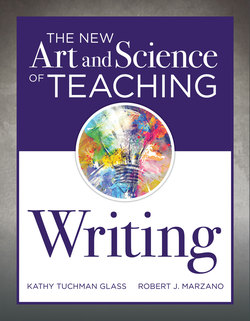Читать книгу The New Art and Science of Teaching Writing - Robert J Marzano - Страница 6
На сайте Литреса книга снята с продажи.
ОглавлениеTable of Contents
About the Authors
Introduction
The Overall Model
The Need for Subject-Specific Models
This Book
Part I: Feedback
1 Providing and Communicating Clear Learning Goals
Element 1: Providing Scales and Rubrics
Element 2: Tracking Student Progress
Element 3: Celebrating Success
Conclusion
2 Using Assessments
Element 4: Using Informal Assessments of the Whole Class
Element 5: Using Formal Assessments of Individual Students
Conclusion
Part II: Content
3 Conducting Direct Instruction Lessons
Element 6: Chunking Content
Element 7: Processing Content
Element 8: Recording and Representing Content
Conclusion
4 Conducting Practicing and Deepening Lessons
Element 9: Using Structured Practice Sessions
Element 10: Examining Similarities and Differences
Element 11: Examining Errors in Reasoning
Conclusion
5 Conducting Knowledge Application Lessons
Element 12: Engaging Students in Cognitively Complex Tasks
Element 13: Providing Resources and Guidance
Element 14: Generating and Defending Claims
Conclusion
6 Using Strategies That Appear in All Types of Lessons
Element 15: Previewing Strategies
Element 16: Highlighting Critical Information
Element 17: Reviewing Content
Element 18: Revising Knowledge
Element 19: Reflecting on Learning
Element 20: Assigning Purposeful Homework
Element 21: Elaborating on Information
Element 22: Organizing Students to Interact
Conclusion
Part III: Context
7 Using Engagement Strategies
Element 23: Noticing and Reacting When Students Are Not Engaged
Element 24: Increasing Response Rates
Element 25: Using Physical Movement
Element 26: Maintaining a Lively Pace
Element 27: Demonstrating Intensity and Enthusiasm
Element 28: Presenting Unusual Information
Element 29: Using Friendly Controversy
Element 30: Using Academic Games
Element 31: Providing Opportunities for Students to Talk About Themselves
Element 32: Motivating and Inspiring Students
Conclusion
8 Implementing Rules and Procedures and Building Relationships
Element 34: Organizing the Physical Layout of the Classroom
Element 39: Understanding Students’ Backgrounds and Interests
Conclusion
9 Developing Expertise
Step 1: Conduct a Self-Audit
Step 2: Select Goal Elements and Specific Strategies
Step 3: Engage in Deliberate Practice and Track Progress
Step 4: Seek Continuous Improvement by Planning for Future Growth
Conclusion
Afterword
Appendix A: Framework Overview
Appendix B: List of Figures and Tables
References and Resources
Index
